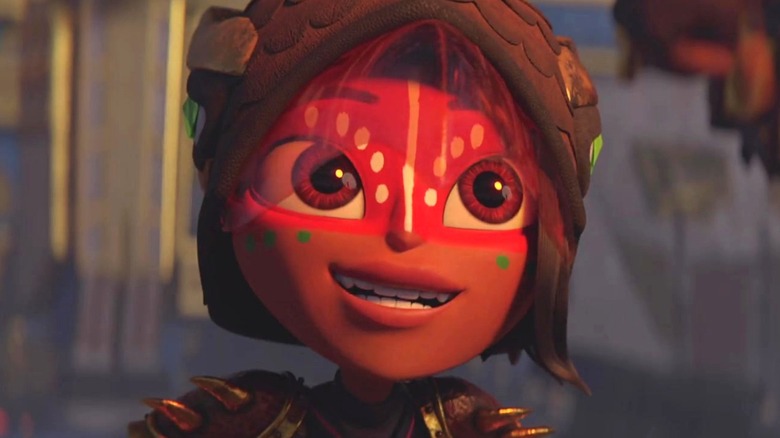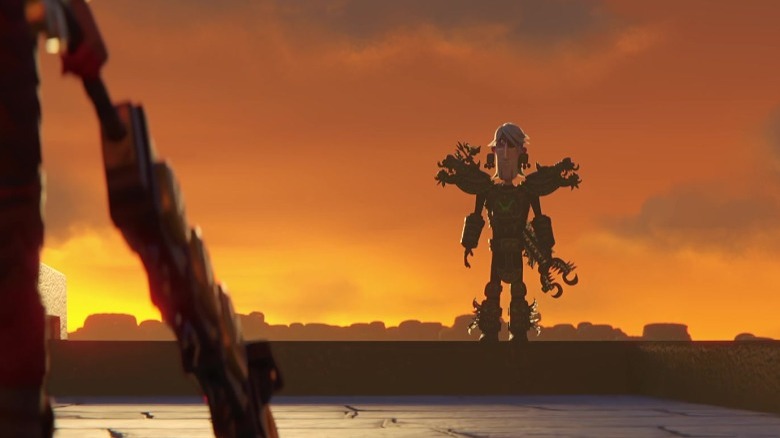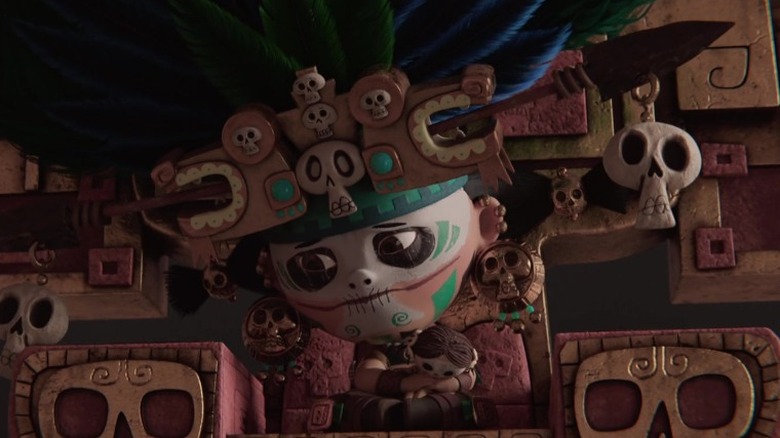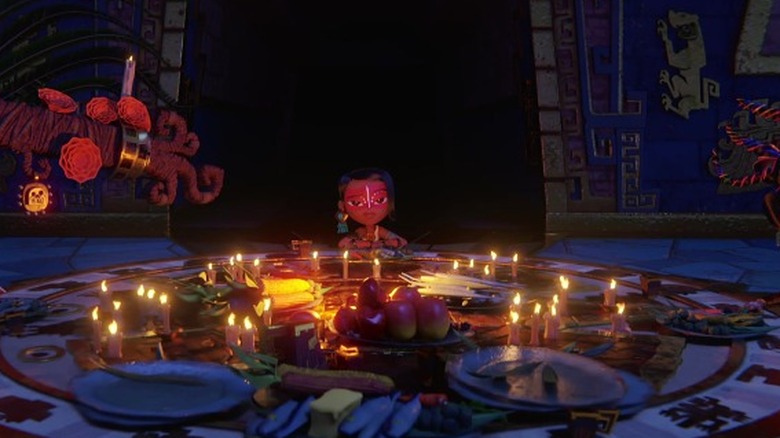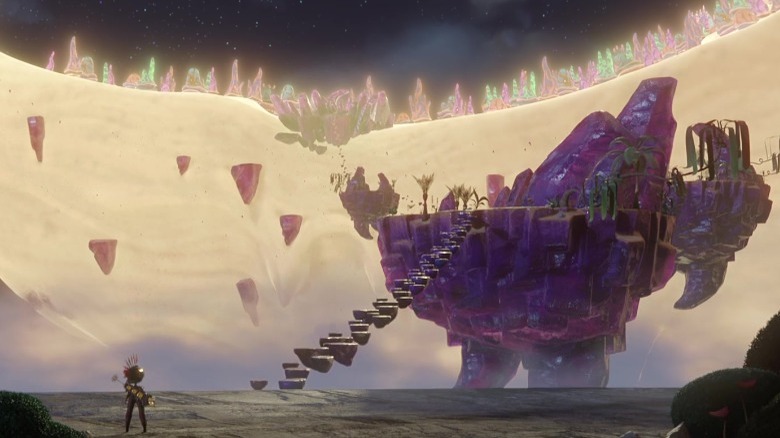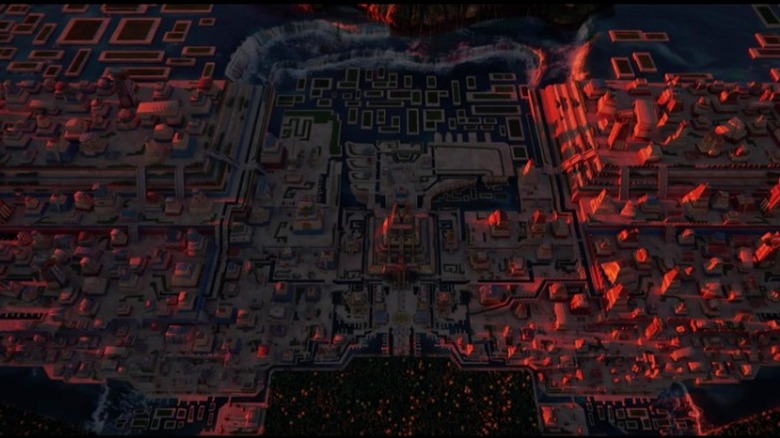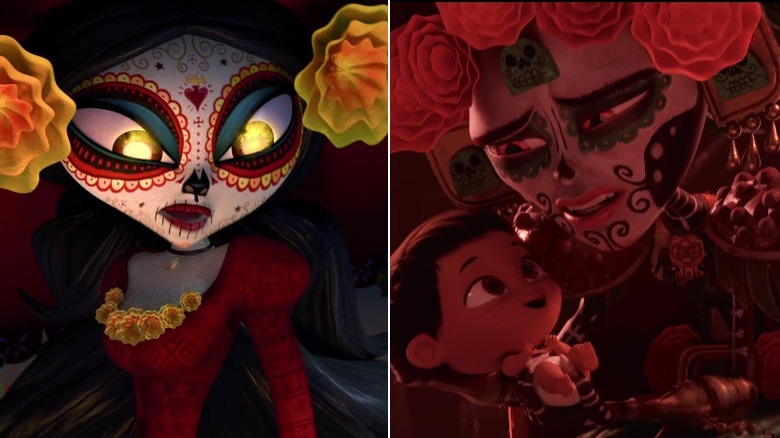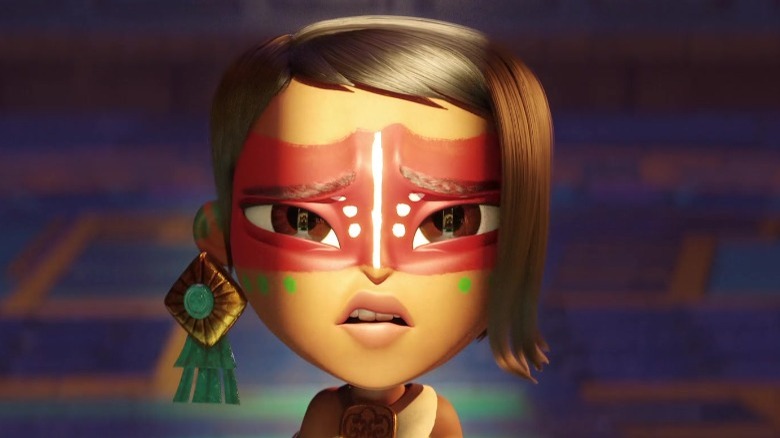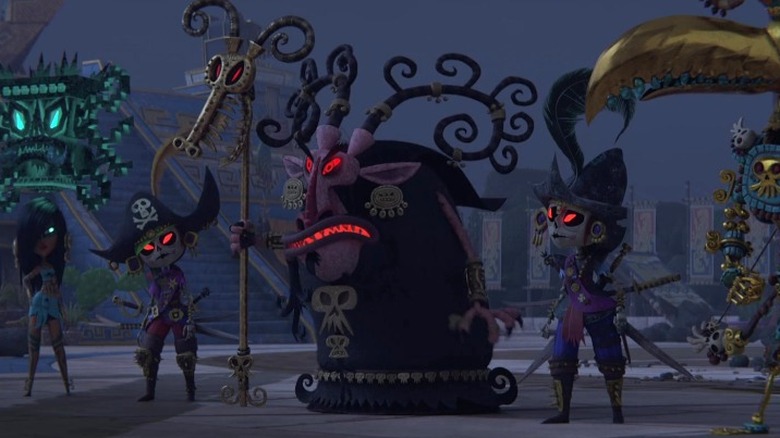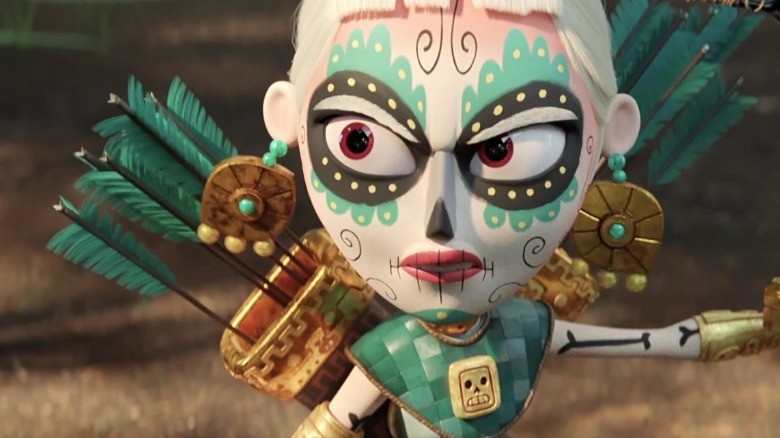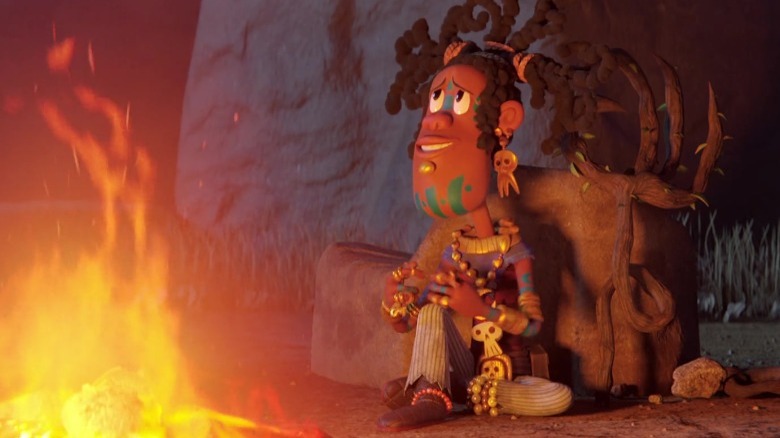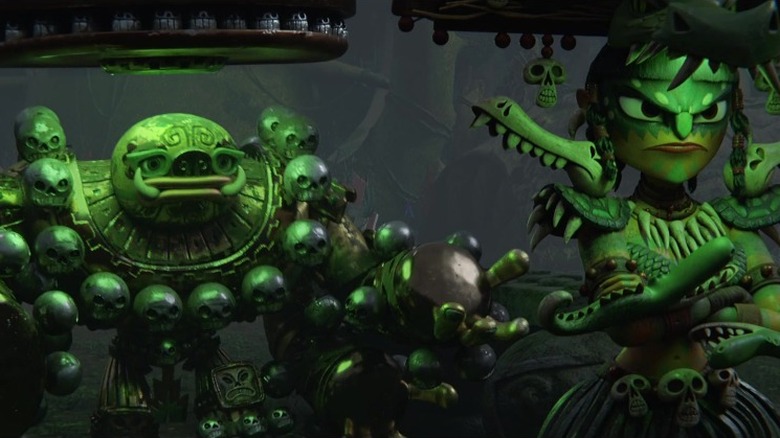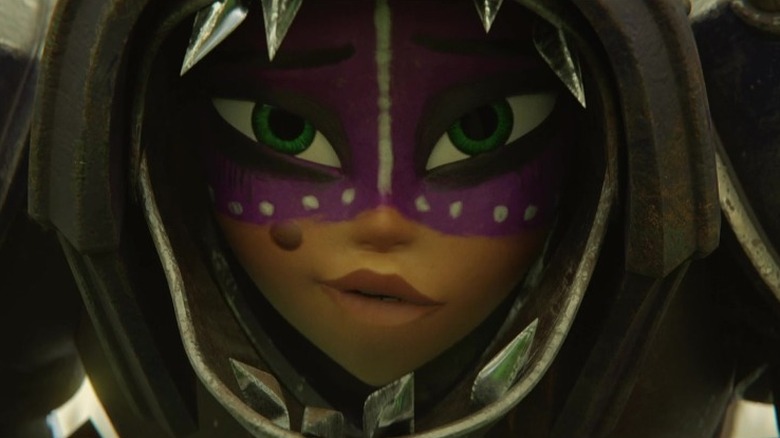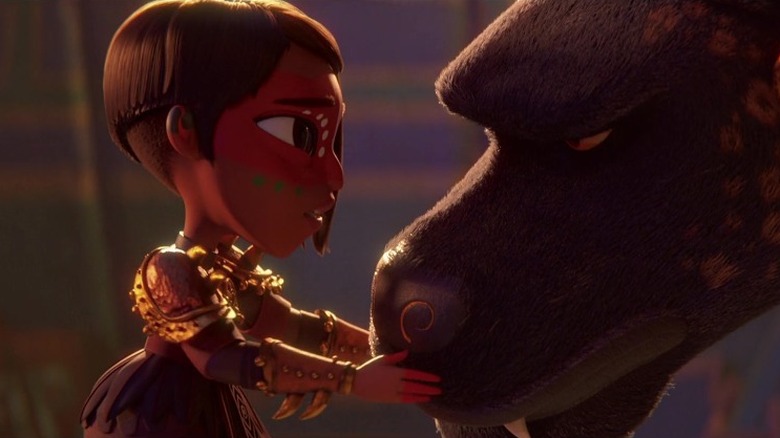Things Only Adults Notice In Maya And The Three
Don't be fooled by the TV-Y7 rating of this new kids' show — there are countless details that only adults will notice and appreciate in "Maya and the Three."
This animated series that kids and adults alike are binging on Netflix is not quite like anything you've seen before. Imagine what would happen if you combined the colorful comic-book visuals of "Spider-Man: Into the Spider-Verse," the darkness of "Kubo and the Two Strings," and the playful irreverence of "Kung Fu Panda." Then animate the whole thing in the unabashedly cartoony style of "The Book of Life," a previous work of director Jorge R. Gutiérrez, and you get "Maya and the Three."
The series revives the same type of character designs that Gutiérrez used for "The Book of Life." However, "Maya and the Three" operates on a much grander scale than "The Book of Life" while tapping into a darkness that exceeds all of Gutiérrez's prior works. Thanks to the shows' mature themes and clever allusions to pop culture, there are layers upon layers that everyone can enjoy. Here are things that only adults notice while watching "Maya and the Three."
Maya and the Three has a few plotholes
"Maya and the Three" has a riveting story and jaw-dropping visuals, but even this amazing show some plotholes. For example, Chimi (Stephanie Beatriz) runs out of arrows in the battle near the end of "Chapter 4: The Skull," yet her quiver is full again in the next scene.
Another issue is that the villain Lord Mictlan (Alfred Molina) waits until he is losing before pulling his next trick from his sleeve. He seriously underestimates the heroes, at first dispatching two teenage gods to kill them. But Zatz (Diego Luna) deserts, while Acat (Chelsea Rendon) comes crawling back after her defeat. Common sense says that if the heroes can easily defeat your weakest minion, you should send an entire army to crush them. Instead, Lord Mictlan just sends out more minions and never more than two at a time. First, he sends Cabrakan and Cipactli, followed by Hura and Can. In "Chapter 6: Maya and the Three," Lord Mictlan catches on and sends a whole army of gods to attack Teca all at once — by which point, Maya (Zoe Saldaña) has assembled the team from the prophecy.
To be fair, "Chapter 9: The Sun and the Moon" lampshades this lapse in logic. Upon learning in the final episode that Zatz can transform into a giant bat, Rico (Allen Maldonado) points out that this is exactly the sort of secret Zatz should've mentioned before their odds of winning got dangerously slim.
The Widow Queen has lost her innocence
When the leaders of each kingdom gather in "Chapter 1: Quinceañera," the Jungle Land sends the Widow Queen (Isabela Merced), a young girl who still plays with dolls. Her father (Jorge R. Gutiérrez) is dead, but even when he was still alive, the Widow Queen carried the world on her shoulders.
The Widow Queen's father was crazy (as in, slide down a step pyramid on the greased bodies of your soldiers crazy). Even worse, he props up the skeleton of his wife on a throne and talks to her as if she was still alive. This would've been enough to scar any child, but the Widow Queen holds it together. Suddenly expected to be the mature one in the room, the Widow Queen grows up too quickly. Even years later, she still feels responsible for righting her father's wrongs. Underneath the queen's cool composure is a little girl deprived of her childhood.
The extent of the Widow Queen's disillusionment becomes apparent when she fights the Goddess of Illusions, Xtabay. The evil goddess (Grey Griffin) disguises herself as the Widow Queen's father, sure the familiar face will make the queen freeze. But the Widow Queen is unperturbed, and she orders her archers to fire. It's not so much that she sees through the illusion. It's more like she wouldn't have trusted her father even if he was him. That's how you know the Widow Queen's innocence is well and truly gone.
Maya and the Three pays homage to telenovelas
"Maya and the Three" was influenced by many different sources, including anime, Saturday morning cartoons, and "The Lord of the Rings." However, adults may also notice that it's also got a bit of soap opera in its DNA. In an interview with Vulture, director Jorge R. Gutiérrez explained that telenovelas were a big part of his childhood, so he made a point to give them a tip of the hat.
"Maya and the Three" certainly gives viewers the sort of family drama you'd find on a Latin American soap opera. The show isn't afraid to breach the subject of cheating partners, which is normally taboo in kids' shows. The show explains that 15 years ago, Maya's father sired Maya in an affair with the goddess Lady Micte (Kate del Castillo), and Queen Teca (Sandra Equihua) was not pleased when she found out.
Things get awkward in "Chapter 8: The Bat and the Owl" when Maya, her father, and both her mothers all sit down at the same dinner table. You can feel all the tension running underneath the surface. Although Queen Teca and Micte both love Maya, they still exchange good-natured jabs at each other and at Maya's father. "We shot and scored [the dinner scene] to make it feel like a telenovela," Gutiérrez told the Los Angeles Times. Adults will appreciate the warm string melody playing in the background and the way the camera circles around the table.
The four kingdoms are each based on a real-life culture
The world of "Maya and the Three" may seem like a fantasy land, but it's actually drawn from real life. Each of the four kingdoms in Maya's world has a real-life counterpart, and while they may not always be 100% true-to-life, as Gutiérrez took some creative liberties, they are carefully designed to represent the spirit of a particular ancient civilization or modern-day community.
Chimi comes from the Jungle Land, which is based on the ancient Mayan civilization. Meanwhile, the Barbarians embody the Incas from the Andes — you might notice that the warrior Picchu (Gabriel Iglesias) is a reference to Machu Picchu. Luna Island — home of Rico the Rooster Wizard — doesn't come from a long-dead civilization but Afro-Latin communities in the Caribbean. Zoe Saldaña told Reuters that Luna Island could represent the Arawak people in particular.
Finally, the heroine Maya hails from the kingdom of Teca, which is this world's equivalent of the Aztecs. As the Los Angeles Times points out, the kingdom's name is derived from the Spanish word for the civilization, Azteca. Also, the finale of "Maya and the Three" is partially inspired by the symbol of an eagle fighting a snake, which the director borrowed directly from an Aztec legend that is depicted on the Mexican flag.
The world of Maya was inspired by indiginous art and architecture
"Maya and the Three" draws heavily from Mesoamerican civilizations like the Mayans, the Aztecs, and the Incas. Gutiérrez took inspiration from each of these indigenous peoples, but he was careful not to limit himself to just what was historically accurate. He and his team quickly discovered that a true-to-life depiction looked "too serious, too archaeological," as he explained to the Los Angeles Times, so they decided to use their research as the building blocks to create a colorful world that captured the essence of these cultures.
The production designer Paul Sullivan noticed that the ancient Mayans incorporated the golden ratio in their architecture, so he used that as a guide for determining the proportions of the Jungle Land. "We put it in the doorways," he told Keyframe Magazine. "We put it in the tree combinations. We put it in the bricks." The show's creators also looked to the Mayans for character proportions too. According to the Los Angeles Times, Gutiérrez and his wife Sandra Equihua studied indigenous artwork and noticed patterns in Mesoamerican caricatures of the human figure, such as huge bodies with tiny legs and giant heads with little eyes, among other things. The show embraced these in its character designs. Gutiérrez and Equihua incorporated all these design elements into their highly stylized concept art, some of which can be seen in "The Art of Maya and the Three."
The director includes easter eggs from his previous works
Jorge R. Gutiérrez's visual style is so unique that viewers can recognize it anywhere. He directed the series "El Tigre" and the film "The Book of Life," both of which have highly-stylized character designs resembling the art of "Maya and the Three." So it comes as no surprise that the director snuck in some easter eggs from his previous works into his new Netflix series. In the brief glimpse of Lady Micte's wedding, Gutiérrez fans will spot right away that all the guests have been lifted straight from "The Book of Life." Beyond that, Bear Killah is obviously based on the villain El Oso from the "El Tigre" TV series. In fact, he is even voiced by the same actor, John DiMaggio.
Observant fans will notice that the director brought back multiple voice actors from "The Book of Life" to participate in his newest project. Out of these performers, three are cast in roles nearly identical to the roles they play in "The Book of Life." Zoe Saldaña plays a kickass princess while Diego Luna plays the dashing young outcast who courts her, although in the 2014 film, Luna was the hero and Saldaña was a supporting character. Furthermore, Kate del Castillo is always cast, without fail, as a goddess of death with a face like a sugar skull.
The show is loaded with pop culture references
Allusions to the director's previous works are only the tip of the iceberg. We could fill an entire article with all the pop culture references in the series, so we'll just try to cover the highlights.
In the final episode, Mictlan gives a sarcastic toast to some characters he has just killed. "Salud, amigos!" he says, which could be a nod to "Saludos Amigos," a wartime Disney film that was one of the first animated films to feature Latin-American characters. Also, the way the gigantic stone heads bounce and roll before assembling themselves into a golem might be a tip of the hat to Yubaba's bouncing heads in the Studio Ghibli film "Spirited Away." Gutiérrez manages to slip in some song references, too. Rico tells Chimi, "To die by your side would be such a heavenly way to die," a line taken right from "There Is a Light That Never Goes Out" by The Smiths.
Even tiny details, like the framing of a single shot, contain pop culture references. There's a shot where Maya unveils her new armor that clearly mirrors an iconic moment from "Batman Begins" where Bruce Wayne unveils his Batman mask. Adults might also notice that Maya straddles Chiapa like a motorcycle and skids the exact same way that Kaneda skids on his bike in "Akira."
Every villain reflects something about the heroes
Each of the main characters meets their ultimate nemesis in "Chapter 6: Maya and the Three." Xtabay (Grey Griffin) taunts Picchu by revisiting his most traumatic memories, Chivo (Carlos Alazraqui) plays on Rico's fear that his friends see him as a fool, and Vucub (Eric Bauza) makes Chimi question her loyalties by reminding her of all the people who call her a monster. Meanwhile, Maya must face Bone (Grey Griffin again) and Skull (Alanna Ubach), who insult the memory of her dead brothers.
The villains aren't the only gods that reflect something about the main characters. All of Lord Mictlan's minions reveal a flaw in one of the heroes. Director Jorge R. Gutiérrez told the Los Angeles Times, "Cabracan and Cipactli, voiced by Danny Trejo and Rosie Perez, are luchador gods that speak to what would happen if her parents were not diplomats and just embraced fighting." Hura and Can (both voiced by Cheech Marin) are also foil characters. The pair always strike in unison with their "god twin powers," and the heroes are only able to defeat by working as a unit. Perhaps the most interesting foil is Acat, the young goddess of tattoos. Impulsive and quick to disobey her elders, she is a picture of Maya's teenage rebellion taken to the extreme. Since Acat's cockiness causes her to fail her mission and die a gruesome death at the hands of Lord Mictlan, this doesn't bode well for Maya.
Maya confronts her own privilege
Don't get us wrong, Maya has got it pretty rough. Even before Lord Mictlan tried to sacrifice her, Maya's life wasn't exactly paradise. Maya's father cheated on his wife, and her parents insist that she can't be a warrior because she's a girl. Also, let's not forget that she lost her three brothers in battle. Yet, as a wealthy princess with a sheltered childhood, Maya is still quite lucky. As Chimi points out, Maya gets to have two mothers, which is two more than any of her companions have.
Rico was already an outsider to begin with. The only reason he got into the Luna Island Academy was because of the generous intervention of Gran Brujo (Wyclef Jean), and even then his classmates still whispered, "This is a school, not a charity." His outcast status only grew worse after he accidentally killed Gran Brujo with forbidden magic. Meanwhile, Picchu's parents and his entire village were massacred by a warrior who took advantage of Picchu's kindness. Chimi has experienced a long list of tragedies. Her mother dies in childbirth, her kingdom exiles her for being albino, and the jungle animals she considered family are killed.
So naturally, Chimi is stung by how Maya complains about never knowing her birth mother, even though she still has two loving parents. After Chimi puts things in perspective for Maya, there is a moment of silence as Maya recognizes just how privileged she is.
Rico is a homage to Jean-Michel Basquiat
As he's expressed on Twitter, director Jorge R. Gutiérrez is a huge fan of the painter Jean-Michel Basquiat. Adults in the audience will even notice that Gutiérrez has given Basquiat a huge tip of the hat by basing Rico's character on the artist.
Gutiérrez told Los Angeles Times, "Rico is Basquiat, who at some point was homeless and went on to be the most highly valued U.S. painter in history." It's quite possible that Rico's backstory is meant to acknowledge Basquiat's troubled childhood. Artsy notes that as a teenager, Basquiat bounced between schools until he ended up in an alternative school. He was later expelled after dumping shaving cream on his principal's head at a graduation ceremony and left home soon afterward, according to The Guardian. Viewers might see a parallel to this in Rico, who loses his chance to get an education at the Luna Island Academy after one of his spells misfires. He is then cast away by Gran Bruja (Queen Latifah), the only family he has left.
The director certainly meant for Rico's design and his clothing style to pay homage to Basquiat. If you compare Rico's curls to one of Basquiat's most iconic hairstyles, the resemblance is uncanny. "That's me giving my love to the Caribbean and everything that they've given us," Gutiérrez told the Los Angeles Times.
Strained relationships are a motif in the show
There are plenty of couples in "Maya and the Three," and adults might notice that the series shows all of them working through their relationship issues.
For starters, there are Maya's parents. While Maya's mother has mostly forgiven her husband for the affair he had 15 years ago, she remains exasperated that he can be so dense and hates it when he is a bad influence on Maya. Next, there's Zatz and Acat, who are living proof that just because two characters have rhyming names, it doesn't mean they are meant to be together. Acat keeps trying to get a kiss out of her unimpressed boyfriend, and viewers can see their breakup coming from a mile off. Also, Cabrakan and Cipactli bicker like an old couple that's been married for centuries. The ambitious earthquake god doesn't even care when his tantrum nearly causes his wife to get crushed under a ton of boulders. Eventually, they pull their marriage together — thanks to a little assistance from "the god of counseling."
At a glance, Lord Mictlan and Lady Micte seem to have a stable relationship, as Micte echoes everything her husband says. However, it turns out that this is only to hide the fact that she is sympathetic to Maya's cause. After Micte decides to stand beside Maya, Mictlan tries to sweet-talk her back into his arms, but Micte knows by now that power is her husband's only armor.
The show explores the moral ambiguity of mercy
In his first scene, Lord Mictlan drops an intriguing one-liner when he says, "The only mercy in war is death." While that may seem like an excuse used by a bloodthirsty war god, it opens the door for some rather mature themes.
When Picchu glimpses the face of one of his foes, she begs him to spare her life, so he allows her to escape. However, the nameless warrior (Grey Griffin) returns to slaughter Picchu's parents and his entire village — and then rubs it in afterward. This adds a moral ambiguity to the rest of the series in that every time one of the heroes shows mercy, we are left with a twinge of doubt. Worst of all, the warrior lets Picchu live, knowing that the burden of being the only survivor is a far worse fate. By now, observant viewers will notice that there's a grain of truth to Mictlan's words. For Picchu, it seems death is the only mercy. In his eyes, the only way to redeem himself is to die a warrior's death.
The show demonstrates that mercy is more than just a noble ideal to be summed up with a simple moral along the lines of, "Mercy is not something you give. Mercy is something you are." Okay, Picchu actually does say that by the end — but knowing how far Picchu has come and what he has lost along the way makes this lesson feel hard-earned.
Chiapa the jaguar has PTSD
Adults might notice that Maya's loyal pet jaguar Chiapa (Dee Bradley Baker) is reminiscent of Cringer from "Masters of the Universe," which is an intentional reference on the director's part, as he revealed to the Los Angeles Times. Like He-Man's famous Battle Cat, Chiapa is a giant feline that you would expect to be ferocious, but he's actually a huge softie. However, Chiapa has a good reason to turn tail — he has PTSD.
Chiapa has seen more trauma than any other character in "Maya and the Three." He joins Maya's father in the fight against Lord Mictlan — and then witnesses the massacre of Teca's army, including Maya's brothers. We learn later that Mictlan used his otherworldly powers of persuasion to make them all kill each other. Chiapa and Maya's father were the only survivors. So whenever Maya asks Chiapa to accompany her, it's no wonder the poor jaguar wants to crawl back into his hole. Just the thought of going back into battle again paralyzes him — viewers can see the reflection of flames in his eyes and hear the distant roar of the battle that Chiapa wants to forget.
Ultimately, Chiapa joins Maya, but he bolts at the first sign of danger for most of their quest. Although Maya is exasperated that Chiapa is such a scaredy-jaguar, it makes perfect sense — it's a defense mechanism. After all, retreating was the only reason he and King Teca made it out alive.
